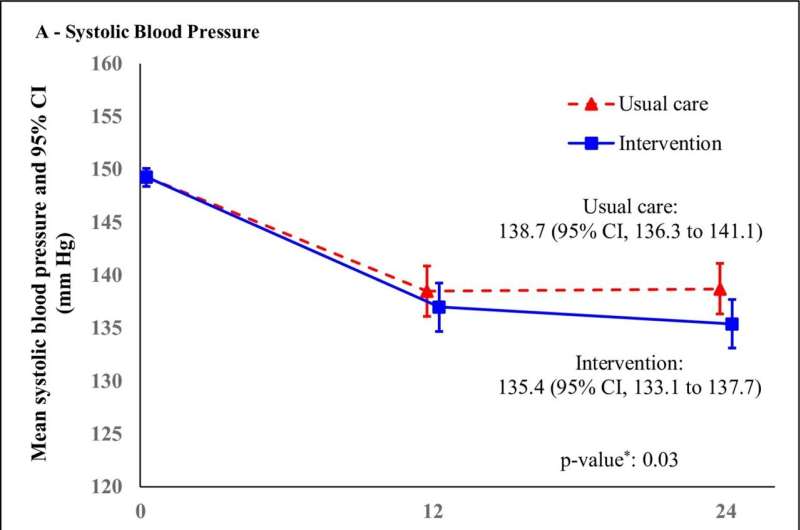Mean SBP and proportion BP controlled by treatment group over time. Panel A: Mean SBP was estimated with a generalized linear MMRM for SBP, with cluster random effects for clinic, and random effects for participants. The I bars indicate 95% CIs. *The p-value for the difference in the mean SBP between 2 treatment groups at 24 months was 0.03. Panel B: Proportions BP controlled were estimated at 12 months and 24 months using a generalized linear mixed-effects model for BP control (SBP <140 mmHg and DBP <90 mmHg) as repeated measures, with fixed effect of baseline SBP, cluster random effects for clinic, and random effects for participants. The I bars indicate 95% CIs. †The p-value for the difference in the proportion BP controlled between 2 treatment groups at 24 months was 0.01. BP, blood pressure; CI, confidence interval; DBP, diastolic BP; MMRM, mixed model repeated measure; SBP, systolic BP. Credit: PLOS Medicine (2022). DOI: 10.1371/journal.pmed.1004026
At least one in three adults in Singapore suffers from high blood pressure (BP)—the most common medical condition managed in the nation's polyclinics, and the leading risk factor for cardiovascular disease and death globally. Even in such a high-income country, fewer than 50% of patients have BP controlled to conventional targets of <140/90 mm Hg.
A cluster-randomized trial conducted by scientists and clinicians from Duke-NUS Medical School and SingHealth Polyclinics has now shown that a low-cost, multi-pronged intervention building on existing primary care resources led to a significant lowering of systolic BP and improvement in BP control after two years of follow up. Use of antihypertensive medications also increased and cardiovascular risk declined.
"Our multicomponent intervention, called SingHypertension, incorporated risk-based treatment by trained physicians prescribing subsidized generic antihypertensive medications including single-pill combination drugs for those at high-risk of cardiovascular disease, nurse-led motivational conversations and telephone follow-ups with patients," said study lead investigator Professor Tazeen H. Jafar, a clinician-scientist from Duke-NUS' Health Services & Systems Research Program.
"The SingHypertension intervention concurrently addressed several barriers faced by patients, physicians and health systems in attaining optimal BP control," said Clinical Associate Professor Tan Ngiap Chuan, Director of Research, SingHealth Polyclinics, and Vice-Chair, Research, SingHealth-Duke NUS Family Medicine Academic Clinical Program, a senior co-author of the study.
Among patients, barriers to hypertension care include poor understanding of hypertension and related cardiovascular disease, lack of motivation to adopt healthier lifestyles, poor adherence to medication and high cost. Among physicians, barriers include clinical inertia to initiate or intensify treatment, reluctance to prescribe single-pill combination antihypertensive drugs and lack of training in health communication. Health system barriers include inadequate funding, lack of performance standards and time constraints in busy clinics.
The SingHypertension intervention led to structured processes to manage patients based on their clinical risk profiles, nurse-led touchpoints to nudge patients toward healthier lifestyle behaviors, and combination medication to reduce dosing complexity and encourage medication adherence. This led to better BP control, reduced cardiovascular risk scores and improved renal function among the patients involved in the study.
In their study published in PLOS Medicine, the researchers emphasized the ease of adapting the intervention into the existing primary care system at low cost—estimated at approximately S$20 (US$14) per participant per month—demonstrating its potential for rapid scalability and sustainability in Singapore and other countries with similar infrastructure.
"Our findings have implications for clinical practice and policy around the world. This intervention is a potentially viable option for many Asian countries with equally high-risk populations and hypertension-related cardiovascular disease burden, similar public health infrastructure, and wide availability of generic single-pill combination antihypertensive medications," Prof Jafar said. "With the potential to easily adapt it to public and private health systems and to rapidly scale up, wide implementation of this intervention could significantly reduce hypertension-related morbidity and mortality in Singapore and globally."
"Hypertension is one of the most common chronic diseases managed in primary care and in the local polyclinics," said Clinical Assoc Prof Tan. "It is also the major determinant of vascular health outcomes such as stroke, heart attack, kidney failure and death in Singapore. Improvement in BP control will mitigate such risks, reduce these preventable complications and help us achieve a 'Healthier SG.'"
The researchers are in discussions with health departments and advisory committees to scale up the intervention across primary care clinics in Singapore. SingHealth Polyclinics and National University Polyclinics will also follow up with a cross-cluster randomized controlled trial based on an enhanced protocol to further evaluate impact on health outcomes and cost-effectiveness.
More information: Tazeen Hasan Jafar et al, Integration of a multicomponent intervention for hypertension into primary healthcare services in Singapore—A cluster randomized controlled trial, PLOS Medicine (2022). DOI: 10.1371/journal.pmed.1004026
Journal information: PLoS Medicine
Provided by Duke-NUS Medical School
























